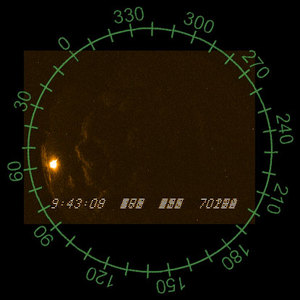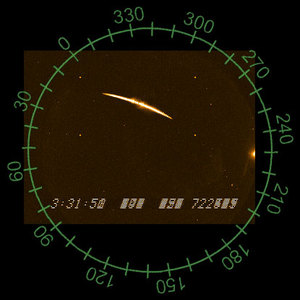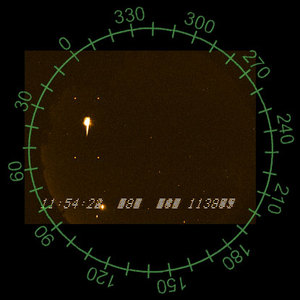
|
| ©Cloudbait |
| August 9th, 2007 |
This fireball occurred at 3:43 AM MDT over northeast Colorado.
The image above is from the Cloudbait camera. Note that the event was bright enough to light up the overhead clouds.
This event happened several days before the peak of the Perseid shower, but does not appear to be related to this shower

|
| ©Cloudbait |
| August 19, 2007 |
This fireball occurred at 9:31 PM MDT over central Colorado. No witness reports.
The image above is from the Cloudbait camera. The setting Moon is seen at the horizon to the right (azimuth 230°). This meteor was not associated with any known shower.
Based on data from three cameras, the meteor appeared over Nederland, CO at a height of 100 km (62.5 mi) and descended to the south (bearing 191°), over the Kenosha mountains and into South Park, ending about 18 km (11 mi) south of Hartsel. Its final height was 53 km (33 mi). The descent angle was 19.9° from horizontal, and the average speed was 55 km/s (124,000 mph). The high velocity, high altitude, gradual increase and decrease in intensity, and lack of fragmentation all suggest that this event probably did not produce any meteorites.

|
| ©Cloudbait |
| October 6, 2007 |
This fireball occurred at 5:54 AM MDT over central Colorado. I have received one possible witness report.
The image above is from the Cloudbait camera. From this location, the meteor brightness was about magnitude -10, or the same as a half Moon. This meteor radiant was at RA=133° dec -19, which is not associated with any known shower.
Based on data from the cameras, the meteor appeared several kilometers north of Castle Rock, CO at a height of 85 km (53 mi) and descended to the northwest (bearing 316°), exploding at a height of 78 km (49 mi) over the Littleton area of Denver. The descent angle was 18.4° from horizontal, and the average speed was 23.9 km/s (54,000 mph). Ordinarily this low speed and shallow descent angle would be a strong indicator for meteorite production, however, the high altitude of fragmentation and large luminous efficiency suggest this meteor was the product of a porous, fragile parent body. As such, it may have burned up completely. If meteorites were produced, I'd anticipate carbonaceous chondrites in the Marston Lake area.



Reader Comments
to our Newsletter